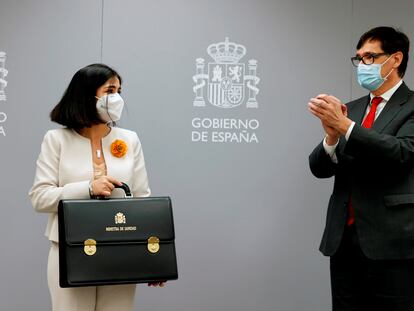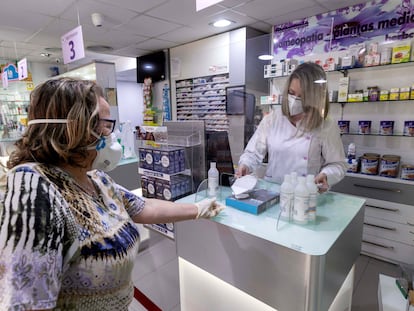How are delays in vaccine deliveries really affecting Spain’s campaign?
The incidents that have been seen so far with Covid-19 inoculations have not significantly affected the plans in this first quarter. The key time for reaching the target of 70% of the population will be spring
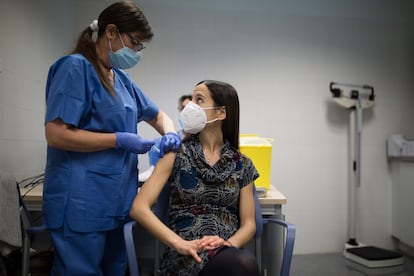
At the current rate, it would take years to vaccinate the entire population of Spain against Covid-19. This assertion, which is being touted by a number of political leaders in the country, is true. But it doesn’t provide any information that we haven’t already known for more than a month now. Barring a few deviations from the plan, this was the expected speed for the early stage of the campaign.
The government is planning for a ramping up of the inoculations once laboratories are able to produce more doses and new vaccines are approved. The delay in the arrival of the available vaccines has, up to now, prompted the reorganization of schedules. But it has not significantly changed the forecasts that were put in place at the end of December, when announcements were made about how many doses would be arriving in the country during the first quarter of the year. Whether or not the government’s objectives are met – i.e. vaccinating the majority of the population by the summer – will not depend on the number of doses that arrive before the spring, which was always due to be very limited, but rather those that start to arrive from that moment onward.
How many vaccines have arrived and how many should have arrived?
By this last week, 1,837,700 doses of the Pfizer-BioNTech and Moderna vaccines were due to have arrived, which is 68,645 more than were received. That’s to say, there was a 3.8% shortfall. The majority of the vaccines that are being administered in this phase are from Pfizer; just 35,700 of the total are from Moderna.
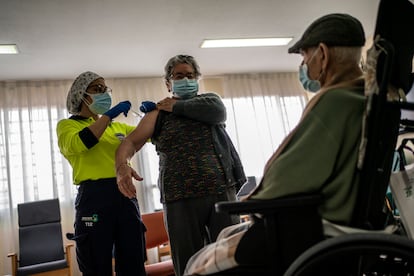
The first problems began the previous week. Pfizer delivered 44% fewer doses than expected: instead of 350,000, the company sent 205,727. This last week they sent the agreed number. Until now, each vial officially contained five doses. Now, after a change in criteria by the European Medicines Agency, a sixth is included. In other words, with the same quantity of the vaccine, a total of 422,000 doses can be administered. This changes the accounting, and also throws up the possibility of the extra dose being wasted should the vaccination teams not have the right syringes – something that has been happening in parts of the country. But even if just five doses are included in the calculations, of the 1.75 million doses that were due to be received by Spain from Pfizer by this point, 1.6 million have arrived – 91% of the total.
The second problem, albeit a minor one in quantitative terms, is the delay with Moderna’s vaccine. By the middle of last week, 52,000 doses were expected – a delivery that was delayed until the weekend.
How many are left to arrive in the first quarter of the year?
The plan was for Spain to receive 4.59 million Pfizer doses and 600,000 from Moderna in the first quarter of the year. The former company has announced that it will increase its production from February 15, meaning that this target figure may actually be exceeded. But even maintaining the current speed, the expected figure will be reached by the end of March. Given that the Pfizer vaccine requires two doses, this quantity will vaccinate 2.3 million people, which is approximately the number of recipients in the first phase of Spain’s campaign: residents of care homes, medical workers and all adults with need for daily assistance even if they are not in residential care. Moderna, meanwhile, delivered 35,700 doses on January 12, and 52,000 more last week. It is due to send 127,000 up to the middle of February and 383,000 more before that month is over.
And here is where the Oxford and AstraZeneca vaccine comes in to play. The inoculation was approved on Friday by the European Commission. Spain was due to receive eight million doses (enough for four million people, given the vaccine also requires two injections) in the first quarter of the year. But the company’s announcement that it would deliver just 38% of the agreed quantities in this period could see Spain receive fewer than four million. This could significantly slow the country’s vaccination plans. It will all depend on the outcome of the negotiations that are currently underway with the European Union, which is trying to minimize the shortfall.
Will the over-80s be vaccinated in March?
After the first phase of the campaign, the next population group will be the over-80s. This group accounts for 2.8 million people in Spain, but some of them will have already been vaccinated in phase 1. To determine whether the vaccination can begin in March, it will be of key importance to know whether the Oxford AstraZeneca vaccine will be given to the over-65s. This is something that is being studied by the Health Ministry, a ministry spokesperson told EL PAÍS.
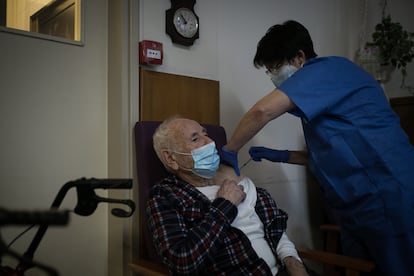
The European Medicines Agency has approved the vaccine’s use in people aged 18 and over. Each country will be able to decide whether it is given to seniors. While clinical trials have shown that it is safe for this group, the sample was not statistically sufficient to determine its efficiency. The Robert Koch Institute, a reference point in Germany for infectious diseases, has recommended that the over-65s should not be given this vaccine in that country. If Spain were to take the same decision, this would most likely mean changing the vaccination plan, and bringing forward another group on the schedule, such as essential workers or those with underlying health conditions, in order to begin using the AstraZeneca vaccine, which could begin arriving in the country very soon.
How many vaccines will arrive in the second quarter?
This is not yet known, and this is the crux of the issue. This figure, and the capacity of Spain’s regions to administer these vaccines in a timely fashion, will determine whether the country is able to vaccinate 70% of the population by the summer, as the government has proposed.
It is currently public knowledge that Spain, via the EU, has signed contracts with seven companies for seven different vaccines. The total number of doses is 140 million, which will be enough to vaccinate 80 million people (Spain has a population of nearly 47 million people) given that most of the vaccines require two doses. But what is not known are the timeframes for delivery.
The forecast is that in the second quarter of the year, companies whose vaccines have already been approved – Pfizer, Moderna and AstraZeneca – will be producing their doses at a greater speed, meaning that more will be arriving every week than are now. What’s more, the Janssen vaccine will likely be available by that point, although it is less effective than the others.
What will need to be done to have vaccinated 70% of the population by the summer?
If 4.6 million people are vaccinated in the first quarter – the total of all of those planned using the Pfizer, Moderna and the worst-case scenario with the AstraZeneca vaccine – 28 million people will need to be immunized to reach 70% of the population. The second and third quarters of the year account for 26 weeks, meaning that more than 2.1 million injections a week will be needed. This figure will come down should the one-dose Janssen vaccine be available. Whatever the case, the current rhythm of the campaign will have to increase.
English version by Simon Hunter.
Tu suscripción se está usando en otro dispositivo
¿Quieres añadir otro usuario a tu suscripción?
Si continúas leyendo en este dispositivo, no se podrá leer en el otro.
FlechaTu suscripción se está usando en otro dispositivo y solo puedes acceder a EL PAÍS desde un dispositivo a la vez.
Si quieres compartir tu cuenta, cambia tu suscripción a la modalidad Premium, así podrás añadir otro usuario. Cada uno accederá con su propia cuenta de email, lo que os permitirá personalizar vuestra experiencia en EL PAÍS.
¿Tienes una suscripción de empresa? Accede aquí para contratar más cuentas.
En el caso de no saber quién está usando tu cuenta, te recomendamos cambiar tu contraseña aquí.
Si decides continuar compartiendo tu cuenta, este mensaje se mostrará en tu dispositivo y en el de la otra persona que está usando tu cuenta de forma indefinida, afectando a tu experiencia de lectura. Puedes consultar aquí los términos y condiciones de la suscripción digital.
More information
Últimas noticias
Most viewed
- Reinhard Genzel, Nobel laureate in physics: ‘One-minute videos will never give you the truth’
- Oona Chaplin: ‘I told James Cameron that I was living in a treehouse and starting a permaculture project with a friend’
- Pablo Escobar’s hippos: A serious environmental problem, 40 years on
- Charles Dubouloz, mountaineering star, retires at 36 with a farewell tour inspired by Walter Bonatti
- Why we lost the habit of sleeping in two segments and how that changed our sense of time

